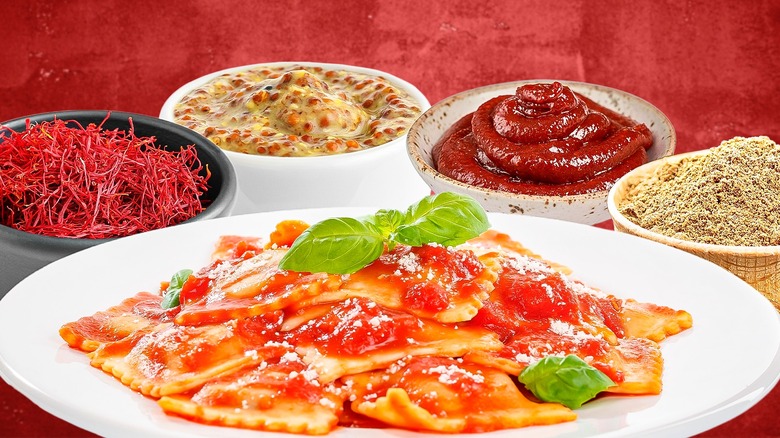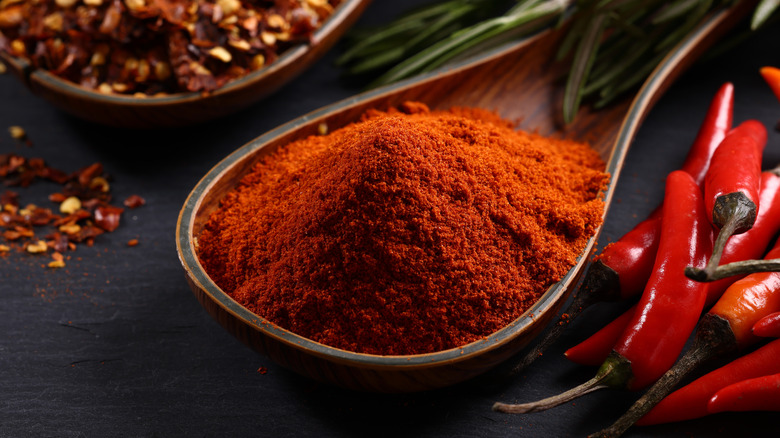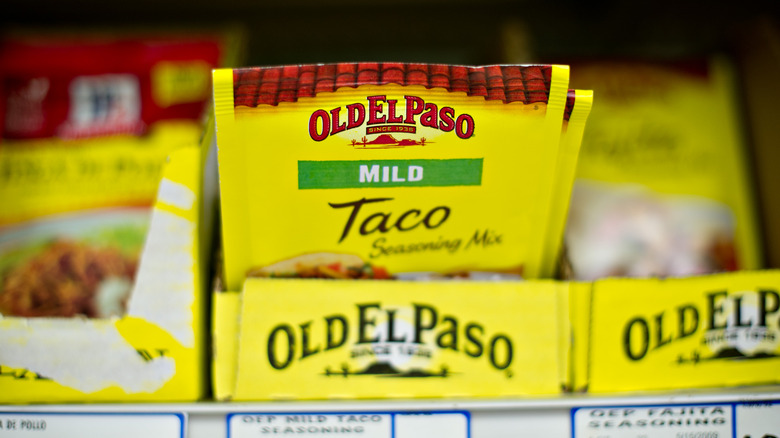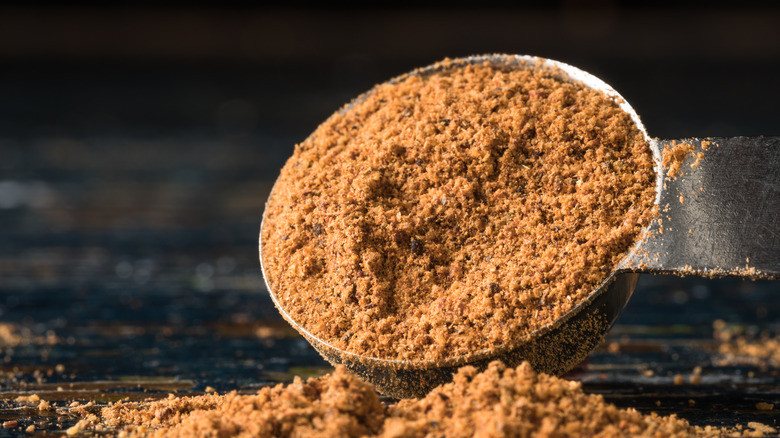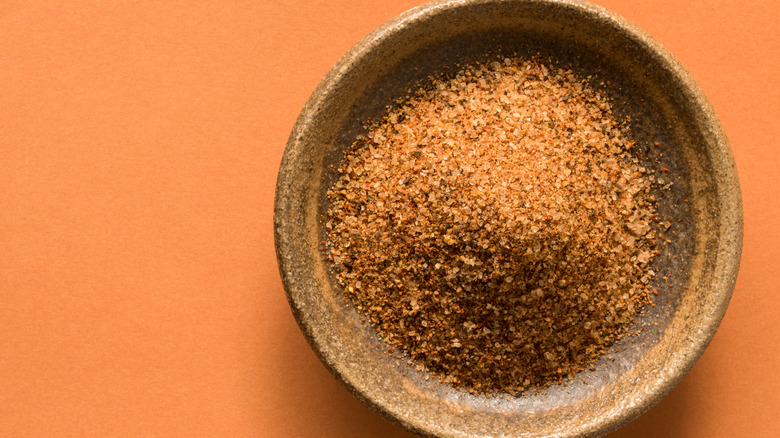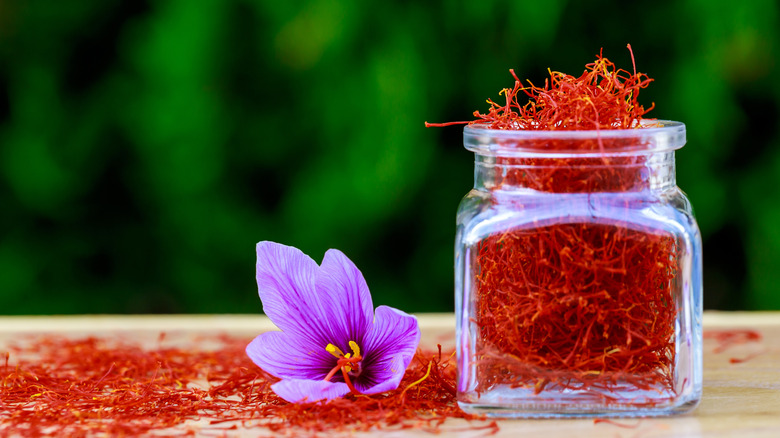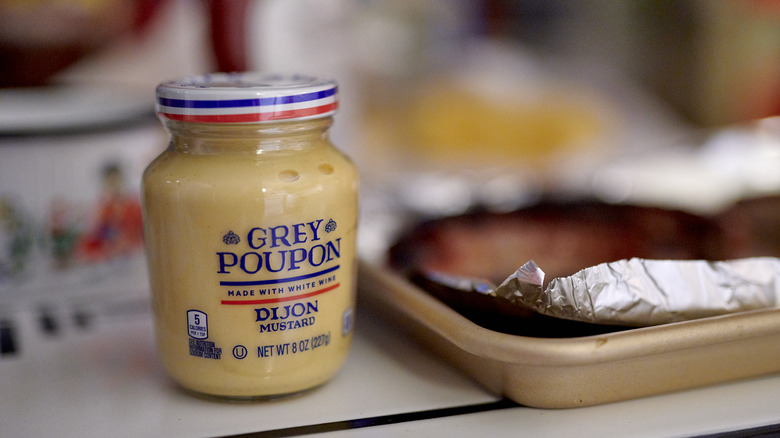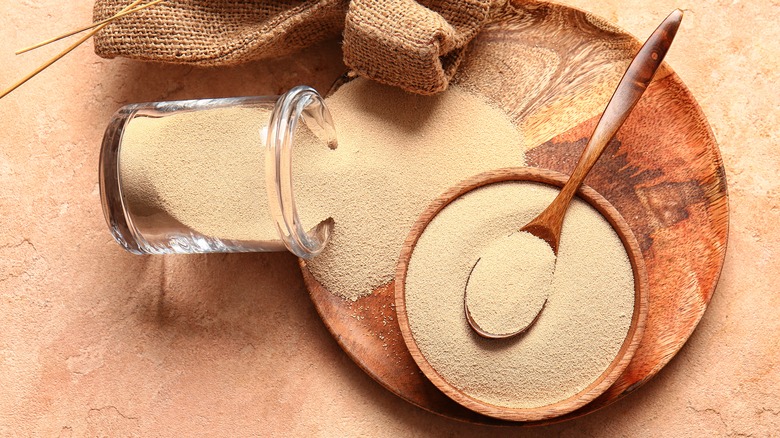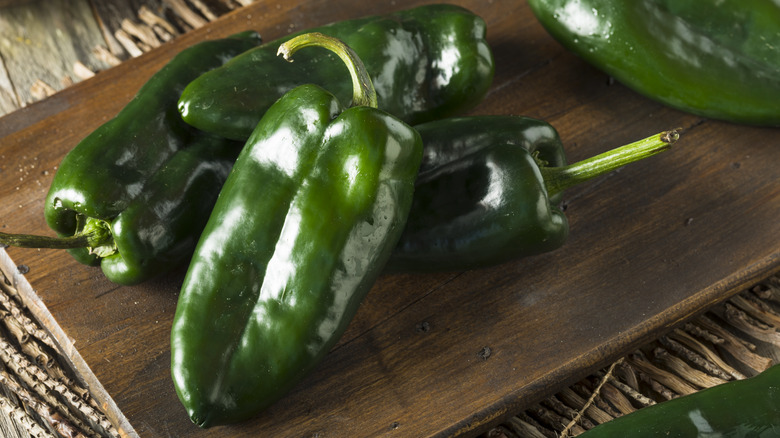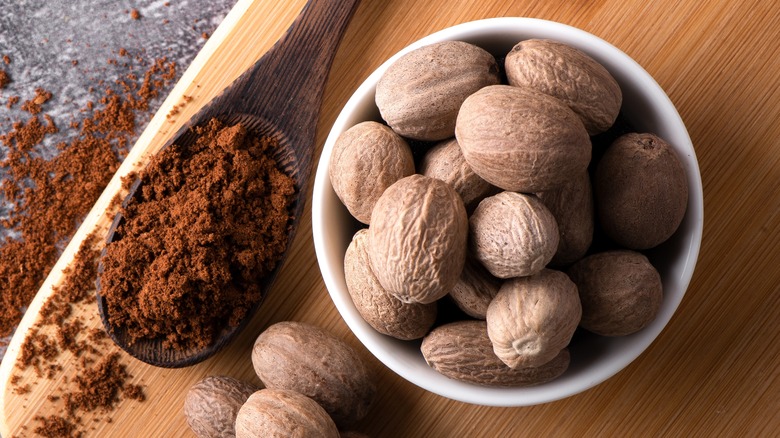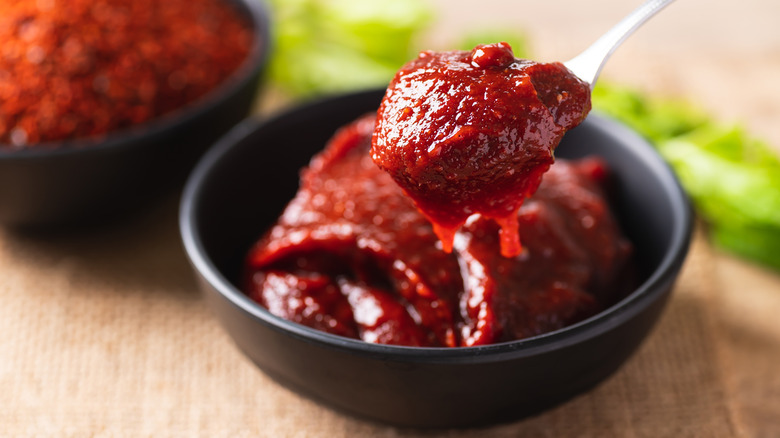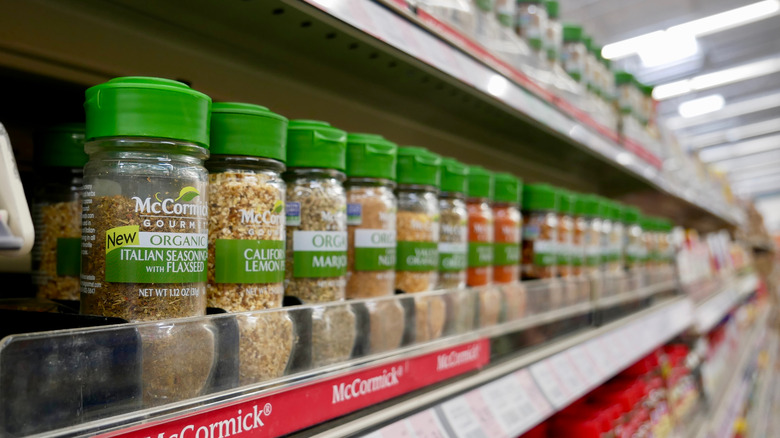11 Unexpected Seasonings To Transform Your Pasta Dishes
If there is any one dish a person knows how to make, it's usually pasta. And maybe scrambled eggs. But at its most basic — meaning a bowl of pasta with butter, olive oil, grated cheese, and maybe a dash of plain tomato sauce — pasta might just be the easiest thing in the world to make. This may be one reason why this staple, often associated with Italian cuisine, transcends borders, coming to act as a culinary canvas upon which countless seasonings and toppings can be used, with varying degrees of success.
Indeed, pasta's versatility knows no bounds. Its power lies in its capacity to harmonize strange and wonderful combinations, effectively acting as a bridge for ingredients you might never think to use together anywhere else ─ like almonds with dill and sardines, or this creepy witch hat pasta with squid ink and pumpkin, perfect for Halloween. Pasta is the great ingredient equalizer, effortlessly taking in disparate flavors from meat, seafood, vegetables, you name it, and delivering a coherent dish even picky eaters can't resist.
This may be why pasta also lends itself so well to unexpected seasonings. We've scoured the pages of our favorite tried-and-tested pasta dishes across Tasting Table, Mashed, and Daily Meal to curate a list of great creative ways to transform this mealtime favorite. Bon appétit!
Paprika
Paprika is a mildly spicy ingredient made from dried and ground chili peppers. You may associate it most closely with Spanish or Hungarian cooking, as both those cuisines rely on it heavily, as seen in the world-famous Hungarian goulash. In America, people commonly use paprika on top of deviled eggs, a simple hors d'oeuvre made with boiled eggs, mayo, and a few other ingredients.
What might surprise you, though, is that paprika, and more specifically paprika-topped deviled eggs, can make an ideal accompaniment to your next pasta dish. Try this tasty deviled egg pasta salad recipe which combines pasta with this popular hors d'oeuvre, and you'll see. Just remember that it's not a matter of making regular deviled eggs and then just stirring them into cooked pasta. This is more of a deconstructed recipe, so be prepared to do some chopping, mashing, and stirring until you end up with what looks like a typical pasta salad. It just won't taste like one.
Taco mix
When you buy packets of taco mix at the grocery store, there is no rule that says you have to bring them home and use them on tacos. You can use them any which way you want, and our suggestion would be to put them on pasta. After all, there is nothing mysterious in those taco mixes — they're simply a combination of different spices, premade and prepackaged for your convenience.
To see for yourself, try this easy chicken fajita pasta recipe, a name that holds a clue to another useful flavor-packet tip: You can also use fajita mix. Whichever combination you go for, just prepare your ingredients and pour in your spice packet along with the vegetable broth and cream, after sautéing the vegetables. If it looks like you have too much broth in there, don't worry, this is by design. To achieve top-level creaminess, this recipe asks chefs to cook the pasta directly in that broth and cream, so there needs to be enough liquid in the pot to allow the pasta to cook. As it does so, it will absorb most of the water, leaving nothing behind but a creamy sauce packed with beautiful southwestern flavors.
Jerk seasoning
Jerk seasoning is often associated with Jamaican cuisine, and can typically be found in jerk chicken marinades or Jamaican curries with sweet potatoes. None of this precludes jerk spices from also being great seasoning for pasta dishes. Try this creamy jerk Rasta pasta recipe immediately and you'll see why.
You can start by going out and buying your favorite jerk seasoning blend, but you also might be surprised to find that you can recreate your own mixture at home. This can be done with spices that you very likely already have in your cupboard, namely brown sugar, chili powder, cinnamon, nutmeg, cumin, salt, and pepper. Mix these together and you've got jerk seasoning, which you can use on pasta or any other recipe you fancy.
In fact, why not combine some of the top jerk-based recipes? The Rasta pasta recipe is basically jerk chicken with pasta, so go ahead and use this hack for jerk salmon, jerk pork, or any kind of protein that has been marinated in jerk sauce. With many marinades you can prepare your dish and just add pasta, or you can follow our Rasta pasta recipe and make your own substitutions. Indeed, one of the best things about this seasoning blend is that it's very forgiving when it comes to change and variety.
Cajun spices
Cajun cuisine is a world away from the simplicity of Italian pasta making, but that doesn't mean the two can't go well together. Indeed, we have not one, but two ways to marry Cajun spices and pasta. First up is our creamy Cajun pasta recipe which asks for the seasoning to be added before the chopped tomatoes and chicken stock go in. This allows the Cajun seasoning to thoroughly soak into the sauté before the liquids come in and disperse what they can. This way, each and every bite of your final product will be packed with flavor, instead of the vegetables just floating tastelessly in a sea of spicy broth. Speaking of broth, don't be scared if it looks like there's too much. You'll need all that water to cook your pasta, which is the part that comes next.
Another great way to enjoy this seasoning in pasta is by using Cajun smoked sausages. This is a little simpler in that you won't have to add actual Cajun seasoning ─ you'll just need to find a sausage that already contains it. Once you've got that, follow the steps and bring everything together into a delightfully creamy sauce by stirring in some cream cheese.
Saffron
When you have an ingredient that is as delicate and rarified as saffron, it's important to keep things simple. There's no point in cooking with this expensive, elusive ingredient if you're just going to overpower it with the blunt force of something like cheese or hot peppers. For this reason, we recommend making saffron the star of the show, whether you're using it on risotto alla Milanese or pasta.
Our creamy saffron butter pasta recipe will illustrate this point to a T. Since this recipe only calls for a few ingredients ─ saffron, butter, pasta, white wine, and cream ─ they should all be of good quality because you're really going to taste them, down to the last molecule. The first order of business should be to get hold of some good quality dried or fresh pasta, but do also pay attention to the rest of the ingredients. The white wine should be dry, so it doesn't introduce an unintended element of sweetness, while the heavy cream should be as fresh as possible.
Mustard
Mustard can add bursts of flavor to pasta dishes in many different ways, sometimes without you even noticing it's there. One such instance is this copycat Panera mac and cheese recipe, which only uses 1 teaspoon of Dijon mustard, but it makes all the difference. Try making this recipe without the mustard and you'll see. This is not the only way to add mustard to your pasta, however. English food writer Nigel Slater adds grainy mustard to browned sausage, along with cream, wine, and crushed red pepper. Doing this will add a bit of a bite to your pasta dish without the need to mess with your béchamel, which is already hard enough to get right as it is.
The list of pasta recipes to which you can successfully add mustard to is long, but the main thing you need to know is that it's best to incorporate it somewhere during the cooking process, rather than stirring it in as an afterthought. This will ensure a more even distribution and a better blend of flavor with the rest of the ingredients.
Nutritional yeast
Although nutritional yeast is not strictly a spice, it should definitely have a spot of its own in your spice cabinet. Aside from adding a touch of protein, vitamins, and minerals to your dish, it can also provide a nice cheesy flavor that is perfectly vegan-friendly. And when paired with miso, there is no stopping this flavor bomb.
One of the best ways to use this ingredient with pasta is in this Instant Pot pumpkin pasta recipe, where the nutritional yeast gets added along with most of the other ingredients, including the pumpkin purée. All in all, this recipe should take you only five minutes to prepare and five minutes to cook, making it one of the quickest ways to a full belly. Even so, the nutritional yeast and miso give this dish a flavor boost that's normally hard to achieve in such a short cooking time. Never mind the convenience of having such a delicious recipe at your fingertips after a busy day at work.
Fresh chili peppers
Adding dried chili peppers to your pasta, either as you cook the sauce or as a finishing touch, is a great way to add a bit of a kick. Even so, this tends to be a superficial flavoring, one that doesn't necessarily blend in with the rest of the ingredients to provide an even layer of taste. For that, you'll need fresh chili peppers.
Our top tip for successfully incorporating fresh chili peppers into your pasta dish is based on this recipe by Italian chef Fabio Viviani, who uses a combination of red bell peppers, poblano peppers, and jalapeño peppers. Sautéing them first, rather than adding them at the end, helps unlock all the spice and flavoring of the peppers, allowing their oils to infuse the rest of the ingredients. Just beware of your proportions; cooking hot peppers introduces even more spiciness into a dish, as the heat from the fire causes the vegetables to release more capsaicin, which is the element responsible for that formidable bite. This dish, with just the right amount of peppers, is sure to deliver a nice, even level of spice throughout, without being too overwhelming.
Nutmeg
Nutmeg is a versatile spice that is often associated with sweet dishes. You'll easily find this ingredient in baked goods like banana bread or pumpkin pie, but it can pair just as well with more savory-leaning powders, like garlic, as it does with sweeter spices such as cinnamon. Indeed, it can even pair with both at the same time, as in the case of jerk seasoning, for example.
A great example of the savory application of nutmeg is Alfredo sauce. This ubiquitous pasta sauce can be found in any grocery store, so all you have to do is procure a jar and when it's time to add the sauce to your pasta, just add a few pinches of freshly ground nutmeg ─ which has a stronger flavor than the pre-ground stuff ─ and stir it into your dish evenly.
If you have a bit more time on your hands, it's also worth making our easy Alfredo sauce from scratch and adding the nutmeg into the recipe along with the salt and black pepper. Another great place to add nutmeg is in a classic ragù alla Bolognese, where the nutmeg goes in with the Parmesan rinds, right before you start simmering the sauce and allowing its flavors to come together. The nutmeg adds the perfect amount of sweetness to what can sometimes bit a bit of an acidic dish.
Gochujang
Gochujang, as a paste, might be almost as versatile as pasta itself. Just add a hint of it to any savory recipe, or even to baked goods, and it will provide a nice, smooth element of spice to your recipe. This is also true of chicken Alfredo pasta, which can incorporate gochujang in a variety of ways.
For one, you could use the gochujang as a marinade for the chicken before you cook it and add it to your pasta. Just brush some gochujang on your chicken and allow it to marinate before cooking it in a skillet, and then follow the rest of the steps for our chicken fettuccine Alfredo recipe. Alternatively, you could mix the gochujang directly into the Alfredo sauce after melting the butter. When it's time to add the lemon juice and cream cheese, just slip in a few teaspoons of gochujang, or as many as you can handle.
McCormick Culinary Salad Supreme Seasoning
When it comes to seasoning, more is definitely more, and no store-bought seasoning mix illustrates that concept more than McCormick Culinary Salad Supreme Seasoning, which incidentally, makes a great addition to pasta dishes. Because, although the name suggests it should be used for salads, which it certainly can, including pasta salads, there's no rule against sprinkling some on top of your hot pasta dishes as well.
In fact this blend, which includes as disparate items as poppy seeds, paprika, Romano cheese, and sesame seeds, can be added to a bland and boring tomato sauce at any stage of cooking. Since it's designed to be sprinkled on cold dishes such as salads, you don't have to worry about it blending into your sauce or causing textural discomfort. In short, this is the ultimate weeknight dinner pick-me-up, as you can simply sprinkle it on top of any dish you want and instantly achieve a luscious, full flavor.
Static Media owns and operates Tasting Table, Mashed, and Daily Meal.
